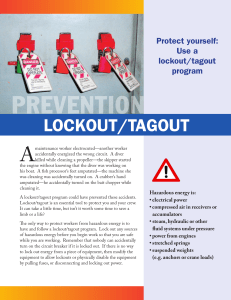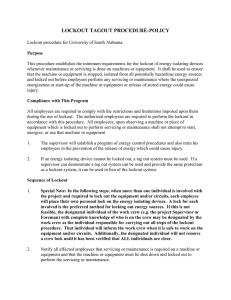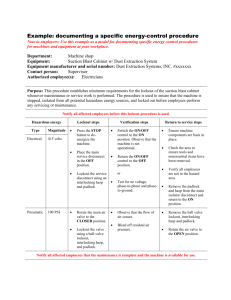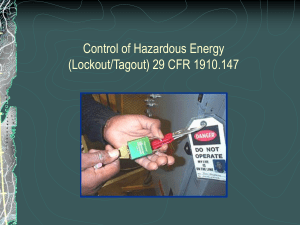WKU HAZARDOUS CONTROL PROGRAM (LOCKOUT / TAGOUT) GENERAL PURPOSE
advertisement
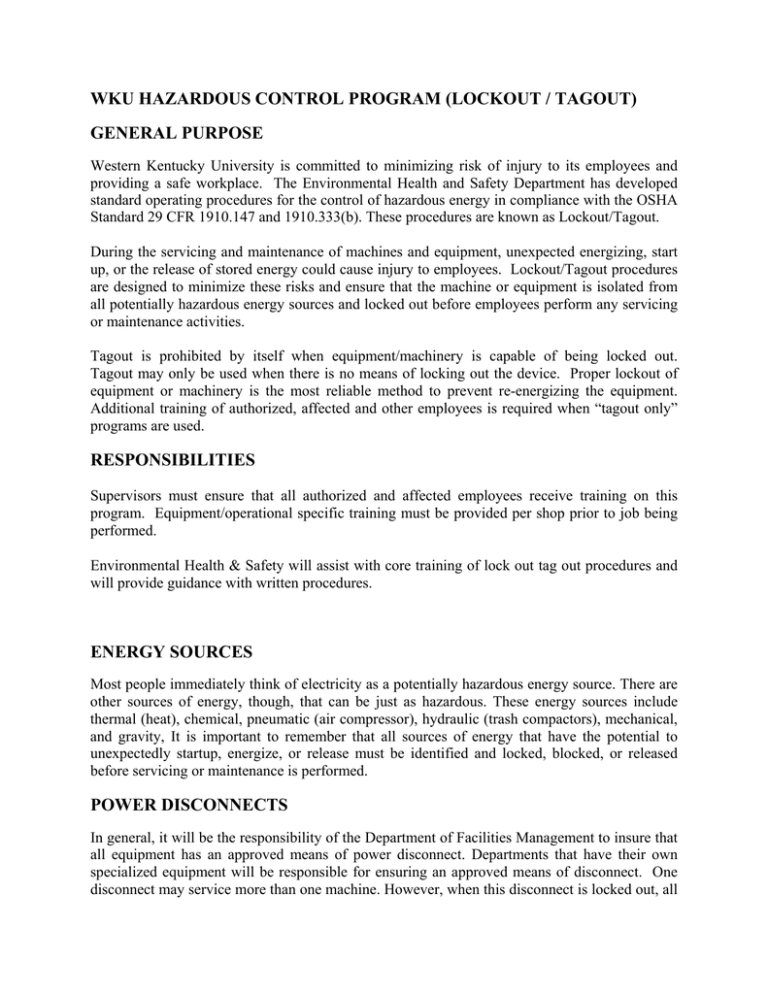
WKU HAZARDOUS CONTROL PROGRAM (LOCKOUT / TAGOUT) GENERAL PURPOSE Western Kentucky University is committed to minimizing risk of injury to its employees and providing a safe workplace. The Environmental Health and Safety Department has developed standard operating procedures for the control of hazardous energy in compliance with the OSHA Standard 29 CFR 1910.147 and 1910.333(b). These procedures are known as Lockout/Tagout. During the servicing and maintenance of machines and equipment, unexpected energizing, start up, or the release of stored energy could cause injury to employees. Lockout/Tagout procedures are designed to minimize these risks and ensure that the machine or equipment is isolated from all potentially hazardous energy sources and locked out before employees perform any servicing or maintenance activities. Tagout is prohibited by itself when equipment/machinery is capable of being locked out. Tagout may only be used when there is no means of locking out the device. Proper lockout of equipment or machinery is the most reliable method to prevent re-energizing the equipment. Additional training of authorized, affected and other employees is required when “tagout only” programs are used. RESPONSIBILITIES Supervisors must ensure that all authorized and affected employees receive training on this program. Equipment/operational specific training must be provided per shop prior to job being performed. Environmental Health & Safety will assist with core training of lock out tag out procedures and will provide guidance with written procedures. ENERGY SOURCES Most people immediately think of electricity as a potentially hazardous energy source. There are other sources of energy, though, that can be just as hazardous. These energy sources include thermal (heat), chemical, pneumatic (air compressor), hydraulic (trash compactors), mechanical, and gravity, It is important to remember that all sources of energy that have the potential to unexpectedly startup, energize, or release must be identified and locked, blocked, or released before servicing or maintenance is performed. POWER DISCONNECTS In general, it will be the responsibility of the Department of Facilities Management to insure that all equipment has an approved means of power disconnect. Departments that have their own specialized equipment will be responsible for ensuring an approved means of disconnect. One disconnect may service more than one machine. However, when this disconnect is locked out, all equipment connected to it must become de-energized. Any equipment that is energized or operated by steam, electricity, water, air, gas, or hydraulic pressure must be locked in an off or neutral position. Cord and plug connected equipment are not required to be locked out as long as they remain under the exclusive control of the employee working on the equipment. Because they are not readily accessible and cannot be locked, a buss plug will not be considered a power disconnect device. A valve will be considered locked-out when it is chained, locked, or enclosed in the off position, and tagged. THE LOCKOUT DEVICE The lockout kit will consist of various lockout devices (all of which are red), small and large Master locks, and tags. Nylon wire ties for the purpose of attaching tags are available in the Facilities Management Stock Room. Any employee who is required to perform set-up, electrical or mechanical repairs, or general maintenance (such as, but not limited to, greasing and oiling) will be provided lockout devices and tags by the manager/supervisor. Padlocks issued to employees for the lockout procedure will be confined to that use only. No other lock will be permitted. Locks for individual employees will be keyed separately. There are no Grand Master keys for these individual locks. The employee will have possession of the only key for their lock. The first lockout device will be provided to the employee at no charge. It will then be that employee's responsibility to maintain the device. Should an employee quit, retire, transfer, be terminated or otherwise leave the employment of the University, the lockout device must be returned to the department Manager/Supervisor. Any lockout device that is lost or intentionally made nonfunctional will be replaced and paid for by the employee. POWER LOCKOUT GENERAL PROCEDURE Each employee or crew performing the work shall lock out the power source of any machine to be repaired, serviced or set up. The only exception to this is when it is absolutely necessary to leave the machinery energized for the purpose of set-up adjustment or troubleshooting. Only qualified, authorized employees shall be permitted to perform those tasks on energized machinery. In addition to disconnecting the power source, it is also required that all residual energy be safely released prior to performing the task. For the purpose of this procedure, the troubleshooting process will be considered ended when: 1. 2. 3. A particular problem has been located and repairs are started. Individual machine components are being replaced. Circuit changes are being made. A lockout device may be removed only by the employee who installed the device or by the employee's direct manager. No other supervisor/manager may order the removal of a lockout device without obtaining approval or written authorization from the manager of the employee that initially installed the lockout device. The procedure for the removal of locks will be periodically re-evaluated. SPECIFIC INSTRUCTIONS 1. Before starting repair or maintenance work on a machine, the supervisor of the department in which the machine is located must be contacted. Before beginning any work, review specific energy control procedures. 2. Call front desk at Department of Facilities 5-3253 when a machine or device must be locked out so date and time may be recorded. 3. Alert the machine operator and/or set-up person. 4. Before starting work, disconnect the equipment from its power source by opening the disconnect switch or removing the plug. In the case of equipment that is powered by air, gas, steam, or fluid power, all valves must be placed in the closed position and all residual pressure relieved. Any machine components that may fall or be activated by gravity must be supported or blocked. Any secondary equipment that could create a hazard to an employee who has been assigned to work on a machine must also be locked out. 5. Attach the lockout device to the appropriate switch, valve, or plug. 6. After the machine has been locked out, activate the machine's operating controls to insure that the power source has been disconnected. When there is the possibility that a disconnected machine may retain excess electrical energy, an electrician must check its circuits to insure that this energy has been discharged and/or dissipated. 7. A crew is considered to be two or more employees from the same department working on the same equipment. If a crew is working on equipment, when locking out a particular machine one of the following conditions must be met to satisfy this procedure: a. Each employee who is working on the machine must place a lock on the lockout shackle. b. One employee may be designated as a crew leader and install one lock for his crew. It will be the crew leader's responsibility to ascertain when the work is completed and that his crew is clear of the machine before removing the lock. c. The supervisor of the department in which the machine is located may place a lockout device on the disconnect. It will then be the supervisor's responsibility to ascertain that all work has been completed and that all crews are clear of the machine before removing the lock. 8. When work is completed, replace all guards and safety devices. When equipment is ready for testing or normal service, check the work area to see that employees are safely positioned or removed from the area. Inspect the work area to ensure that nonessential items have been removed and that the machine or equipment components are operationally intact. The appropriate employee, crew leader or department supervisor should then remove the lockout device and restore power after alerting concerned personnel 9. After it is determined that the machine is functioning correctly, it may be released for production. 10. Each employee or crew leader must remove his lockout device upon completion of the assignment. If work is to be continued by that same employee on the following day, his/her lock and tag may be left. In the event that it is not possible to complete the repair or maintenance assignment by the end of the shift, and work will be continued by employee(s) on another shift, the employee or crew leader's lockout device should be replaced by the lockout device of an employee or crew leader who will be continuing the work on the following shift. Another way to keep the lockout in effect during a shift change is for the manager of the department performing the work to place a departmental lockout device and tag on the machine. The manager must leave written instructions for the next shift manager. These instructions should include the nature of the work being performed and its current status. 11. Only the employee who put the lock on the energy-isolating device shall remove it. However, when the authorized employee who applied the lock is not available to remove it, it may be removed under the direction of the manager, but only if first: a. b. c. d. It is verified by the manager that the authorized employee who applied the lock is not at the facility. All reasonable efforts to contact the authorized employee have been made in order to inform the employee who applied the lock that his/her lock has been removed. The manager ensures that the machine is safe to operate, and It is made certain that the authorized employee has this knowledge before he/she resumes work. TEMPORARY REMOVAL OF LOCKS In those situations where the lock must be temporarily removed from the energy isolating device and the machine or equipment energized to test or position the machine, equipment or component thereof, the following sequence of actions shall be followed: 1. Clear the machine or equipment of tools and materials; 2. Remove employees from the machine or equipment area; 3. Remove the lock; 4. Energize and proceed with testing or positioning; 5. De-energize all systems and reapply energy control measures in the sequence set forth in Appendix A and continue the servicing and/or maintenance; and TAGS Lockout is the preferred method to guard against injury. The use of tags in the de-energization process and in preventing unauthorized start-up of machines/equipment is therefore limited to: 1. Machinery and equipment with the energy isolating devices that are not capable of being locked out. 2. Special and temporary situations where use of a tagout system will provide full employee protection. The tags to be used in those situations will be provided by the company. Each tag must indicate the identity of the employee who applies it. The tags to be used have been determined by the company to be capable of withstanding the environment to which they are exposed for the maximum period of time that exposure is expected. Tags having reusable, non-locking, easy means of attachment/detachment (such as string, cord, or adhesive) are not permitted. All tags to be used are non-reusable, self-locking, and attachable by hand, non-releasable with a minimum locking strength of no less than 50 pounds, and have the general design and basic characteristics of being at least equivalent to a one-piece, all-environment-tolerant nylon cable tie. Nylon ties are available in the Facilities Management stockroom. Each tag contains a warning against hazardous conditions if the machine or equipment should be energized. They contain words such as: DO NOT START DO NOT OPEN DO NOT CLOSE DO NOT ENERGIZE DO NOT OPERATE Any person who knows of the use of any tag that does not satisfy these requirements must immediately report that fact to his supervisor. That supervisor shall take immediate steps to ensure that the tag in question satisfies the above or that a suitable replacement tag is provided. TAGOUT PROCEDURE In those instances where machinery or equipment is tagged out rather than locked out, the lockout procedures listed above will be followed except that the tags described above will be used instead of locks. The following additional requirements will also be met: 1. Tagout will not be used unless it will provide a level of safety equivalent to that obtained by the lockout procedures. 2. Additional safety measures beyond those necessary for lockout must be taken-such as the removal of an isolating circuit element, blocking of a controlling switch, opening of an extra disconnecting device, or the removal of a valve handle to reduce the likelihood of inadvertent energization. 3. An authorized employee shall affix the tag to each energy-isolating device. 4. The tag shall be affixed in such a manner as to clearly indicate that the operation or movement of energy isolating devices from the "safe" or "off” position is prohibited. 5. When a tag is used either by itself or in addition to a lockout device, the tag attachment shall be fastened at the same point that the lock is attached. However, when a tag cannot be affixed directly to the energy isolating device, the tag shall be located as close as safely possible to the device, in a position that will be immediately obvious to anyone attempting to operate the device. 6. A tag may be removed only by the employee who placed it there. employee is unavailable, tag removal must have management approval. 7. No tag will be bypassed, ignored or otherwise defeated. The warning stated on tags must be observed by all employees at all times. 8. The tags must be securely attached to each energy-isolating device so that they cannot be inadvertently or accidentally detached during use. 9. All employees must keep in mind at all times that tags are WARNING DEVICES that are put in place for their protection. They do not provide physical restraint like a lock does. 10. Instruction and training on the use and limitation of tags is included in our training sessions. Additional training of authorized, affected and other employees is required when tagout programs are used. 11. Each supervisor with responsibility for an area or process where machinery or equipment is tagged out must pay close attention to all employees in the area to see that these rules are observed. He/she shall take immediate action to protect their safety whenever it becomes necessary and, when appropriate, shall immediately invoke disciplinary procedures. If that TRAINING The WKU Environmental Health and Safety Department provides a training program for all employees who work with machinery or equipment subject to lockout/tagout requirements, including those employees who do not work directly on that machinery or equipment but whose work operations are or may be in the area. Job specific will be trained by manager or supervisor of that area. Departments who have their own specialized equipment will provide specific training. An employee must successfully complete the training program before he/she will be permitted to work in the area of, or perform any servicing or maintenance upon, any machinery or equipment that is subject to OSHA lockout/tagout requirements. Refresher training will be offered periodically. The training program has been designed to educate our employees in their respective roles in the control of hazardous energy, the knowledge that they must possess to accomplish their tasks safely and to ensure the safety of fellow workers as related to the lockout/tagout procedures. Training objectives include: Ensure that employees understand the purpose and function of the hazardous energy control program; Teach authorized employees the skills for safe application, usage and removal of energy control devices; Train authorized employees to recognize hazardous energy sources, the type and magnitude of the energy and the methods necessary for energy isolation and control; Make employees aware of the limitations of the use of tags, when tagout only systems are used; and Ensure that all other employees whose work operations may be in or near an area where energy control procedures are used are able to recognize when the control procedure is being implemented. They must also understand the purpose of the procedure and the importance of not attempting to start up or use the equipment that has been locked and/or tagged out. Retraining will take place for all authorized and affected employees whenever there is a change in their job assignments, a change in machines, equipment or processes that present a new hazard, or when there is a change in the energy control procedure. Retraining may also be given to reestablish employee proficiency in the case of inadequate knowledge or use of the energy control procedures. The WKU Environmental Health and Safety Department will maintain Lockout/Tagout training records. APPENDIX A LOCKOUT / TAGOUT PROCEDURES 1. Preparation for shut down: To prepare for shut down authorized employees will notify all associates who will be in the area: *That the equipment is to be locked out for servicing and/or maintenance. *To be cautious and careful not to activate any movement on this piece of equipment. The authorized employee will notify the front desk if necessary (if turning off the circuit breaker will affect other areas). The authorized employee will also notify the front desk at Facilities Management (745-3253) if performing lockout/tagout on a piece of equipment with multiple sources of energy. Review specific energy control procedures. 2. If the equipment is in operation, shut it down: Follow normal procedures to turn off the equipment. 3. Identify all energy sources and isolate: Identify the electrical energy source shut off control and turn off (isolate) the electrical energy source from the equipment. For plug-in equipment remove the plug from the energy source. 4. Lock out the energy isolating device(s) with assigned individual locks: Place a lockout device, padlock and tag on the energy source cut off device or plug. Exception: If the authorized employee has control of the plug at all times no lockout is required. 5. Release and isolate all stored energy sources: Stored or residual energy (such as that in capacitors, springs, rotating flywheels, hydraulic systems and air, gas, steam or water pressure, etc.) must be dissipated or restrained by methods such as grounding, repositioning, blocking, bleeding down, etc. 6. Test the equipment to verify energy sources have been disconnected: Test electrical connections with a voltmeter while controls are in on position. After verifying that the power is disconnected, be sure to return the controls to the neutral or off position. 7. Restore Equipment to Service: After servicing and repair has been accomplished, do the following: *Reassemble all removed components including guards. *Remove all tools or other item not belonging to the equipment *Ensure all employees are clear. *Verify that all the controls are in neutral. *Remove all lockout / tagout devices. *Re-energize the equipment. *Test equipment for proper operation *Notify affected employees that maintenance is completed and equipment is ready to use.

